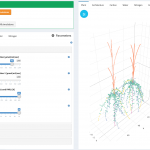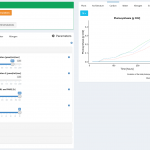PlaNet-Maize
Guillaume Lobet, Loic Pagès and Xavier Draye (UCLouvain, INRA and FZJuelich)
Overview
| Model category | FSPM |
|---|---|
| Plant part | Whole_plant |
| Scale | Whole_plant |
| Licence | open_source |
| Operating system | MacOs, Windows, Linux |
| Programming language | Java, R |
| Format of model inputs and outputs | xml |
| Species studied | Maize |
| Execution environment | Console, Web-based |
Scientific article
A modeling approach to determine the importance of dynamicregulation of plant hydraulic conductivities on the water uptakedynamics in the soil-plant-atmosphere systemGuillaume Lobeta,Loïc Pagès and Xavier DrayeEcological Modelling, 2013-22-11 View paper
Model description
We present here a new model, PlaNet-Maize, with the purpose of investigating the effect of environmental and endogenous factors on the growth and water relations of the maize plant. This functional–structural plant model encompasses the entire soil-plant-atmosphere continuum with a sub-organ resolution. The model simulates the growth and development of an individual maize plant and the flux of water through the plant structure, from the rhizosphere to the leaf boundary layer. Leaf stomatal conductance and root radial and axial conductivities are considered as functions of local water potential. Finally, a simple carbon allocation rule is included in the model to allow the feedback effect of water deficit on plant growth. The model was successfully used to reproduce experimental plant hydraulic behavior in response to water deficit. The quantitative contribution of leaf conductance and root conductivities were assessed individually and in combination. Our results highlight the importance of regulating hydraulic properties in FSPM as these can strongly modify the water uptake dynamics and lead to emerging water uptake behaviors. The modeling results also indicate that plant hydraulic properties can theoretically be tailored to improve plant water use in challenging environments.
Some case studies

